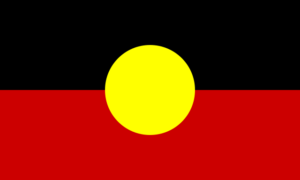The Overlooked Story of Australia’s Bushfires
 Australian Aboriginal flag
Australian Aboriginal flag The whole world has been watching for months as massive bushfires spread across Australia. Much concern has been voiced regarding who is being devastated most, with a sharp focus on land loss and animals and very little mention of the Aboriginal community (two New York Times articles in the last two days being a welcome exception). When Australia’s leaders were questioned about lack of preparedness for the disastrous fire season, rhetoric did shift towards the Aboriginal community, but in the vein of “who could have prevented the fires” instead of “who’s heritage and history is being stripped from this preventable catastrophe.” Very little has been done to give Australian Aboriginal people a platform to speak on not only the ancestral practices of preventing bushfires but the simple affirmation of the communities’ existence amongst the climate change conversation. But the bigger question about what became a catastrophic megafire is, how did it even start in the first place?
Australia has always experienced bushfires, as indicated by the designation of fire season.” But due in part to climate change, this year’s fire season has been a lot worse than what is considered normal. Fires can start for many reasons—from natural causes, such as lightning strikes or an accidental spark, to not-so-natural, such as deliberate fires. This season’s fires were due to a natural weather phenomenon known as the Indian Ocean Dipole (IOD), which brought hotter, drier spells than usual. The areas experiencing higher levels of heat included areas around Sydney and Adelaide. As well, rising levels of CO2 are warming the planet. This ripple effect of hot weather not only means potential fires but long periods of drought.
For those tuned into the IOD, it was only a matter of time until the fires were more than folks could handle. But could this have been prevented? The answer lies in those who know the land better than those who colonized it, the Aboriginal community.
The Aboriginal people of Australia have always practiced bushfire control methods, which have been taught generation after generation. These techniques and methods can lessen fire damage by reducing fuels. If fires begin, Aboriginal elders have ways to restrict the fires to smaller areas, which results in less harm to the land. These tactics are extremely vital not only to preserving land but to the people who practice them. As Sky Thomas—my sister (as we say in our communities as a form of endearment), friend, and a community leader of the Gunnai/Kurani, Yorta Yorta, and Wiradjuri Klan—told me, the land is more than just land.
[It is] our spiritual connection in physical form (which is the land) is up in flames. The land of which we’ve been responsible in caring and nurturing for thousands of years, that role torn from us, is dying. And yet, we are once again ignored, pushed aside. No one talks about how this impacts us. How our communities and livelihoods are being destroyed. No one’s coming to our rescue. In Australia we’ve always been our own. Our people have been neglected help, robbed of our basic human rights, disconnected once more from family and homes. When are people going to start realizing you lose far more than lives you hold no value to if we are gone?
In order to fight back climate change, the original people of the land must be sought for advice, wisdom, and guidance. The Indigenous community knows how to interpret the land around them; the trees, for example, are indicators of the fires of the past and those to come. Take the balga tree. The fires that occur around it produce colored rings, which the community interprets to determine annual growth and which trees have been killed by fires. These rings can provide information dating back several centuries. Community members can accurately assess the fire practices that promote access to vegetation, maintain its pattern, and encourage the development and growth of new vegetation that then attracts game for hunting. This natural cycle is all within the knowledge of the Indigenous people of Australia. Although some fire agencies of the country have used these methods, the effort needs to intensify and experts (the community) need to be involved.
Like many Aboriginal, Indigenous, and Native communities throughout the globe, the original caretakers of this ancient land have knowledge that is needed. I only hope that the nation’s leaders value their knowledge and their existence on the land. When will those in power understand that the real power lies in the people they have colonized? When will they take the hint that maybe, just maybe, if the original people of the land are listened to and given the space to make policies and legislation, we will then see real and effective preservation?
